RBSE Solutions for Class 9 Maths Chapter 2 Number System Additional Questions is part of RBSE Solutions for Class 9 Maths. Here we have given RBSE Rajasthan Board Solutions for Class 9 Maths Chapter 2 Number System Additional Questions.
| Board | RBSE |
| Class | Class 9 |
| Subject | Maths |
| Chapter | Chapter 2 |
| Chapter Name | Number System |
| Exercise | Additional Questions |
| Number of Questions Solved | 40 |
| Category | RBSE Solutions |
RBSE Solutions for Class 9 Maths Chapter 2 Number System Additional Questions
Multiple Choice Questions
Question 1.
Which of the following (RBSESolutions.com) is irrational?

Solution
D
Question 2.
Between two rational (RBSESolutions.com) numbers, there is/ are:
(A) exactly one rational number
(B) no rational number
(C) infinitely many rational numbers
(D) only one rational number and no irrational number
Solution
C
![]()
Question 3.
\(0.34\overline { 67 } +0.13\overline { 33 } \) is equal to:

Solution
B
Question 4.
The rational number for the (RBSESolutions.com) recurring decimal 0.5353… is:

Solution
B
Question 5.
\(0.\overline { 36 } \) expressed in the (RBSESolutions.com) form \(\frac { p }{ q }\) equals to:

Solution
A
Question 6.
Decimal representation of an (RBSESolutions.com) irrational number is always:
(A) terminating repeating
(B) terminating
(C) non-terminating repeating
(D) non-terminating non-repeating
Solution
D
Question 7.
Every terminating decimal is:
(A) a natural number
(B) a rational number
(C) an integer
(D) a whole number
Solution
B
Question 8.
Which of the following (RBSESolutions.com) is different from others?
(A) √3
(B) √8
(C) √11
(D) √9
Solution
D
Question 9.
The value of \(0.\overline { 002 } \) in the form \(\frac { p }{ q }\), where p and q are (RBSESolutions.com) integers and q ≠ 0 is:
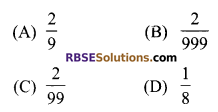
Solution
B
Question 10.
The value of √32÷√2 is equal to:
(A) √30
(B) 4
(C) \(\frac { 1 }{ 4 }\)
(D) 16
Solution
B
![]()
Very Short Answer Type Questions
Question 1.
Express the following in the form \(\frac { p }{ q }\), where p and q are (RBSESolutions.com) integers and q ≠ 0.
(i) \(0.\bar { 6 }\)
(ii) \(0.4\bar { 7 }\)
(iii) \(0.\bar { 001 }\)
Solution.
(i) \(0.\bar { 6 }\)
Let x = \(0.\bar { 6 }\) (Pure recurring decimal)
i.e. x = 0.6666 …(1)
Multiplying (1) by 10, because (RBSESolutions.com) ones digit i.e. 6 is repeating, we get
10x = 6.6666 …(2)
Subtracting (1) from (2), we get
10x – x = (6.6666…) – (0.6666…)
⇒ 9x = 6
⇒ x = \(\frac { 6 }{ 9 }\)
⇒ x = \(\frac { 2 }{ 3 }\)
(ii) Let x = \(0.4\bar { 7 }\) (Mixed recurring decimal)
i.e. x = 0.47777 …(1)
Multiplying (1) by 10, to make it (RBSESolutions.com) pure recurring decimal, we get
10x = 4.7777 …(2)
Further multiplying (2) by 10, we get
100x = 47.777 ….(3)
Subtracting (2) from (3), we get
100x – 10x = (47.777…) – (4.7777…)
⇒ 90x = 43
⇒ x = \(\frac { 43 }{ 90 }\)
(iii) Let x = \(0.\bar { 001 }\)
i.e. x = 0.001001001 …(1)
Multiplying (1) by 1000, we get
1000x = 1.001001 …(2)
Subtracting (1) from (2), we get
1000x – x = (1.001001…) – (0.001001…)
⇒ 999x = 1
⇒ x = \(\frac { 1 }{ 999 }\)
Question 2.
Express 3.2 in the form \(\frac { p }{ q }\), where p and q are (RBSESolutions.com) integers and q ≠ 0.
Solution.
Let x = \(3.\bar { 2 }\) (Pure recurring decimal)
i.e. x = 3.2222 ……(1)
Multiplying (1) by 10, we get
10x = 32.2222 ……(2)
Subtracting (1) from (2), we get
10x – x = (32.222…) – (3.222…)
⇒ 9x = 29
⇒ x = \(\frac { 29 }{ 9 }\)
Question 3.
Express \(15.\bar { 712 }\) as a fraction (RBSESolutions.com) in the simplest form.
Solution.
Let x = \(15.\bar { 712 }\)
i.e. x = 15.7121212 …(1)
Multiplying (1) by 10 and 100 successively, we get
10x = 157.121212 …(2)
and 1000x = 15712.1212 …(3)
Subtracting (2) from (3), we get
1000x – 10x = (15712.1212…) – (157.1212…)
⇒ 990x = 15555
⇒ x = \(\frac { 15555 }{ 990 }\)
⇒ x = \(\frac { 1037 }{ 66 }\)
Hence, \(15.\bar { 712 }\) = \(\frac { 1037 }{ 66 }\)
![]()
Question 4.
Is π is a rational (RBSESolutions.com) number?
Solution.
No, is an irrational number.
Reason: π is the ratio of the circumference of a circle to the length of its diameter. The value of π is approximately equal to \(\frac { 22 }{ 7 }\) but not exactly, i.e. π = 3.14159265…
Here in the value of π, no sign of recurrence of the digits was found.
Hence π is an irrational number.
But if we will take the value of π exactly equal to \(\frac { 22 }{ 7 }\) i.e. \(\frac { 22 }{ 7 }\) = \(3.\bar { 142857 }\) then it is said to be rational.
Question 5.
Express 0.00323232 … in the form \(\frac { p }{ q }\), where p and q are (RBSESolutions.com) integers and q ≠ 0.
Solution.
Let x = 0.00323232…
Then 100x = 0.323232 ……(1)
and 1000x = 32.323232 …(2)
Subtracting (1) from (2), we get
9900x = 32
⇒ x = \(\frac { 32 }{ 9900 }\)
⇒ x = \(\frac { 8 }{ 2475 }\)
Question 6.
Simplify each of the (RBSESolutions.com) following expressions:
(i) (3 + √3)(2 + √2)
(ii) (3 + √3)(3 – √2)
(iii) (√5 + √2)2
(iv) (√5 – √2)(√5 + √2)
Solution.
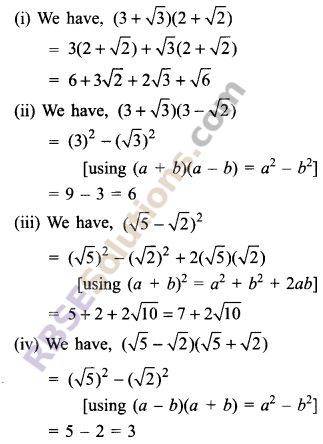
![]()
Question 7.
Simplify each of (RBSESolutions.com) the following:

Solution.


Question 8.
Simplify \(\left( \frac { 8 }{ 125 } \right) ^{ -\frac { 4 }{ 3 } }\)
Solution.
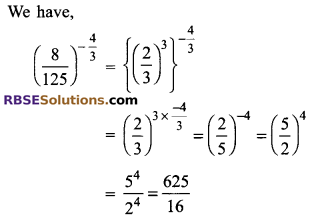
Question 9.
Solve for x: \(\left( \frac { 1 }{ 7 } \right) ^{ 4-2x }=\surd 7\)
Solution.

Question 10.
If \(\left( \frac { 1 }{ 5 } \right) ^{ 3y }\) = 0.008, then find (RBSESolutions.com) the value of (0.25)y
Solution.
We have, \(\left( \frac { 1 }{ 5 } \right) ^{ 3y }\) = 0.008
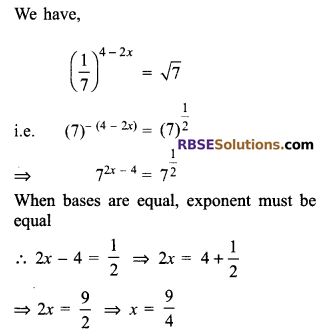
![]()
Short Answer Type Questions
Question 1.
Show how √5 can be represented (RBSESolutions.com) on the number line.
Solution.
On the number line, in the figure, we have marked two point O and P representing numbers 0 and 2 respectively.
We draw PQ = 1 unit ⊥r to the number line at P.

Now taking O as center and radius OQ = √5 we draw an arc which intersects the number line at the point N.
We observe that ON = √5 (radius)
Therefore, point N on the number line represents the irrational number √5
Question 2.
Locate √2 on the number line.
Solution.
On the number line, in the figure, we have (RBSESolutions.com) marked two points O and A representing numbers 0 and 1 respectively.

We draw AB = 1 unit ⊥r to the number line at A.
Now, join OB, we find that
OB = √(OA2 + AB2) = √(12 + 12) = √2
Now taking O as centre and radius OB = √2, we draw (RBSESolutions.com) an arc which intersect the number line at the point L.
We observe that OL = radius = √2.
Therefore, point L on the number line represents the irrational number √2.
Question 3.
Locate √11 on the number line.
Solution.
On the number line, point O represent 0 and (RBSESolutions.com) the point L represents 3.
Thus, we have OL = 3 units.

Now, with O as centre and radius ON = √11 we draw an arc which (RBSESolutions.com) intersect the number line at the point R.
We observe that OR = √11 (radius).
Therefore, the point R on the number line represents the irrational number √11.
Question 4.
Express \(2.4\bar { 178 }\) in the form \(\frac { p }{ q }\), where p and q are integers and q ≠ 0.
Solution.

![]()
Question 5.
Find two irrational (RBSESolutions.com) number between \(\frac { 1 }{ 7 }\) and \(\frac { 2 }{ 7 }\).
Solution.
On dividing 1 by 7, we get
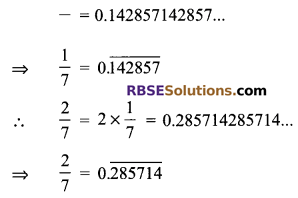
To find a irrational number between \(\frac { 1 }{ 7 }\) and \(\frac { 2 }{ 7 }\), we find numbers which are non- terminating and non-repeating. There are such infinite numbers.
Two of them may be (RBSESolutions.com) considered as 0.150150015000…, 0.220220022000…
Question 6.
Show that 0.142857142857… = \(\frac { 1 }{ 7 }\).
Solution.
Suppose x = 0.142857142857 …….. (i)
Multiplying (i) by 1000000, we get
1000000x = 142857.142857 …….. (ii)
Subtracting (i) from (ii), we get 999999x = 142857
999999x = 142857
x = \(\frac { 1 }{ 7 }\)
Hence, 0.142857142857… = \(\frac { 1 }{ 7 }\).
Question 7.
Rationalise the (RBSESolutions.com) denominator of \(\frac { 6 }{ \surd 12-\surd 3 }\)
Solution.

Question 8.
Find the value of x, if \(\sqrt [ 3 ]{ 3x-2 } =4\)
Solution.

⇒ x = 22
![]()
Question 9.
Express the following irrational numbers/surds with (RBSESolutions.com) a rational denominator.

Solution.



Question 10.
Rationalise the (RBSESolutions.com) denominator of \(\frac { { a }^{ 2 } }{ \sqrt { { a }^{ 2 }+{ b }^{ 2 } } +b }\)
Solution.

Long Answer Type Questions
Question 1.
Visualize 3.765 on the number line (RBSESolutions.com) using successive magnification.
Solution.

In figure (i) we observe the location of 3.765 between 3 and 4. Now, we magnify (RBSESolutions.com) the line segment between 3.7 and 3.8 and divide it into ten equal parts as shown in figure (ii). The location of the number 3.765 is in between 3.760 and 3.780. Again we magnify the line segment between 3.760 and 3.780 and divide further into ten equal parts. The position of the number 3.765 is clearly located at the number line as shown in figure (iii).
Question 2.

Solution.
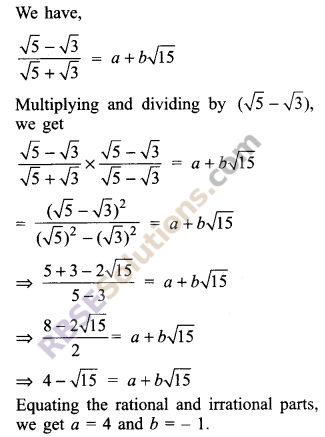
![]()
Question 3.

Solution.

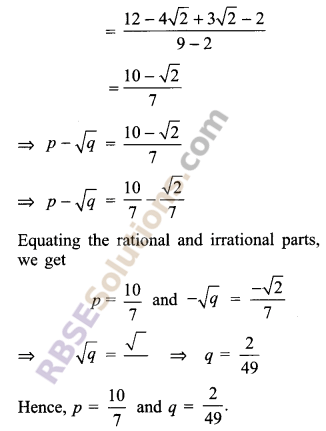
Question 4.
Rationalize the (RBSESolutions.com) denominator and simplify

Solution.


Question 5.

Solution.

Question 6.

Solution.


![]()
Question 7.
Simplify the (RBSESolutions.com) following:

Solution.

Question 8.

Solution.


Question 9.

Solution.

Question 10.

Solution.
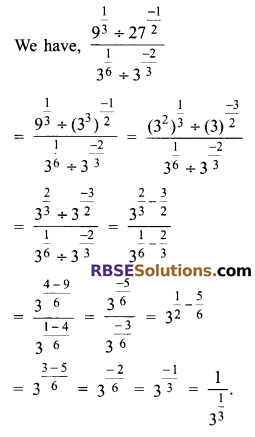
![]()
We hope the given RBSE Solutions for Class 9 Maths Chapter 2 Number System Additional Questions will help you. If you have any query regarding RBSE Rajasthan Board Solutions for Class 9 Maths Chapter 2 Number System Additional Questions, drop a comment below and we will get back to you at the earliest.